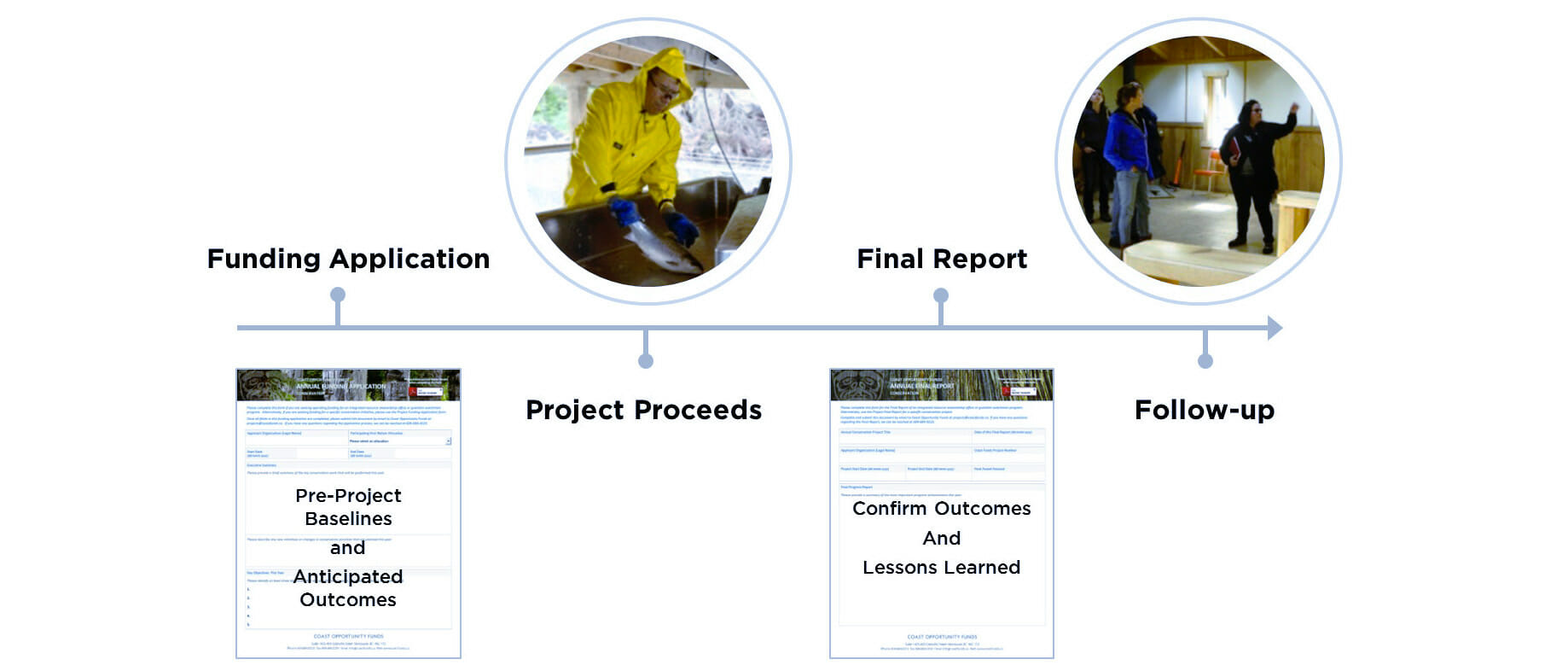Outcomes Measurement Methodology
We have collaborated with First Nations and our funders to create an effective means of indicating how First Nations are strengthening community well-being since the inception of Coast Funds.
Coast Funds uses an outcome measurement methodology that is shared between the conservation and economic development fund. Together with First Nations, we determined that there are four key areas to measure First Nations’ strengthening of community well-being that include: Environmental Conservation, Economic Prosperity, Social Empowerment, and Cultural Vitality.
Embedding Measurement in the Grantmaking Process
A key of our approach to measuring outcomes is ensuring that data collection and reporting is as streamlined as possible for First Nations. Coast Funds and the First Nations have designed the process of measuring outcomes to be intuitive and collaborative while directly contributing to strengthening community well-being (i.e. the application and reporting process itself builds ongoing capacity for program and financial management). Equally as important, the process has been designed to ensure that all outcomes measurement is standardized and replicable across a diversity of programs, themes, and Nations.

In order to achieve a streamlined, user-friendly approach to data collection and reporting, we embed the collection of baseline (pre-project) data in the funding application stage. Every applicant completes an Adobe Acrobat PDF, providing baseline figures that can be compared with actual project-based outputs in the future.
Similarly, every final report requires that First Nations explain (in quantifiable and narrative terms) the economic, environmental, social, and cultural outputs from their approved project. Once reports are validated by Coast Funds staff, all project-based outputs are compiled in a database for further analysis and public reporting.
Project-Based Measurement – Outcomes are Under Reported by Design
As First Nations collect and report all data on a per-project basis, our outcome measurement methodology has been focused on the specific conservation initiatives and economic development projects that have been funded by Coast Funds. This focused scope of measurement enables a high level of data integrity as we work with First Nations to check for errors or duplication and ensure accuracy of project reports. As a result, the aggregate of project-based outputs into regional short-term outcomes is representative of First Nations achievements through Coast Funds supported projects.
First Nations are strengthening community well-being in numerous ways beyond their Coast Funds projects, and as such, outcome measurement reported by Coast Funds should be deemed as only partially illustrative of the progress that First Nations are achieving. Similarly, as a charitable foundation, we do not have a regulatory role with regards to resource management and consequently measures do not attempt to address areas of ecosystem-based management or protected area management that are the purview of other organizations or government.
Outcome Reporting Timeframes
Outcome reporting for community well-being indicators is comprised only of projects that have been completed with an approved final report on file with Coast Funds. Exceptions include the “Attracting New Investment” and “Diversifying the Economy” indicators under Economic Prosperity, which includes projected sources of funding that First Nations have specified in funding applications for projects that are approved, but not yet completed. A footnote accompanies every indicator noting the timeframe that is reported and any nuances regarding data collection or aggregation. At any given time, Coast Funds has up to 100 active projects that have not yet provided a final report. Over time, as final reports are completed, we aggregate completed project outputs in the year that the project was completed, not reported (e.g. when a First Nation provides a final report in 2016 for a project that completed in 2014, Coast Funds compiles all project-specific outputs into aggregated outcome reporting for 2014).
Definitions
Indicator is the measure for each output provided through the reporting process with First Nations and Coast Funds (i.e. # of new jobs, or # of completed protected area management plans). These indicators can be measured project-by- project for their unique contribution to overall strengthening of community well-being.
Outputs are captured and quantified for each indicator when Coast Funds compiles a single project report from a First Nation (i.e. three new full-time jobs created, or one conservancy management plan completed). Outputs are validated by First Nations with descriptive narratives documented in each detailed project report submitted to us.
Short-term Outcomes are compiled as an aggregate of multiple First Nations’ project-based reports (i.e. 658 new permanent jobs have been created or 12 conservancy management plans have been completed overall).
Long-term Outcomes are indicated by assessing the change in economic prosperity, environmental conservation, social empowerment, and cultural vitality since the Great Bear Rainforest agreements and inception of Coast Funds through (1) community-based evaluation, (2) follow-up reports on Coast Funds project five years after their completion, and (3) comparison with socio-economic data prior to the inception of Coast Funds.
Further Reading
Our methodology was informed by consultation with First Nations and funders, but also numerous academic and public policy reports including Measuring Impact – produced by the United Kingdom during their 2013 G8 Presidency. The subject paper provides illustrative examples and best practice guidelines for goal setting, development of framework and metrics, collection and storage of data, validation of data, data analysis, data reporting, through to data-driven investment decisions.
Additionally, a number of reports from the OECD, United Nations Development Programme, Bill and Melinda Gates Foundation, London School of Business, and others are available from Intermountain Impact Investments.